This study determined effect of phosphorus (P) rates on growth, yield and phosphorus use efficiency (PUE) of potato varieties propagated from apical rooted cuttings. Experiments were conducted at Egerton University, Njoro and Kenya Agricultural and Livestock Research organization, Molo, in a split plot arrangement in randomized complete block design with three replicates. Main plot factors were four potato varieties (Shangi, Dutch Robyjn, Unica and Wanjiku) and sub plot factors were four P levels of triple super phosphate (0, 30, 60, 90 kg P ha-1). Data on growth, yield and PUE of potato were collected. Phosphorus rates had significant effect on plant growth and yield. The interaction effects of P rates and varieties on plant survival, plant height, shoot biomass, number of eyes and tuber size was significant. The interaction of Wanjiku and 30 kg P ha-1 gave the highest shoot biomass of 0.42g per plant and large sized tubers (> 60 mm diameter). The main effects of variety and P rates significantly affected days to physiological maturity and marketable tuber yield. Unica variety showed high P uptake and PUE at both study sites. Apical rooted cuttings and 30 kg P ha-1 is recommended in the study areas with similar agro ecological zones.
Potato (Solanum tuberosum L.) is the world’s fourth most important food crop after maize, rice and wheat. It is an important source of carbohydrate, protein, vitamins B and C and also minerals. It provides a source of income and is important in food and nutritional security (Islam and Nahar, 2012). Potato is the second most consumed crop in Kenya, after maize (Janssens et al., 2013). It is mainly cultivated by small scale farmers in the highland areas of Kenya at altitudes ranging between 1200 to 3000 meters above sea level. The area under potato production is 192,341 hectares with average yield of 79,020 tonnes per hectare (FAO, 2018). Smallholder farmers propagate potatoes using seeds saved from the previous season’s harvest. Diseases and pests subsequently accumulate and cause losses in production (Tsoka et al., 2012; Muthoni et al., 2013). Propagation of potato from rooted apical cuttings offers an alternative for farmers. They are clean planting materials with ability to regenerate rapidly and can increase potato yield and quality. They are thus ideal for conservation of potato seed, storage and distribution of the potato germplasm through breeding lines and varieties (Yasmin et al., 2011).
Potato has a high phosphorus (P) demand as compared to other crops (Hopkins et al., 2014). P is important for vine growth, tuber formation, tuber bulking and tuber starch synthesis (Atkinson et al., 2003; Hopkins et al., 2014; Nyiraneza et al., 2017). It has a low P uptake efficiency due to its shallow root system. Majority of roots are found in the top 30 cm of the soil (Mikkelsen, 2014). Differences in the rooting systems and utilization ability of genotypes influence optimum rates to be applied (Fernandes et al., 2014). To get the most benefit from fertilizer application, placement and rate of application is critical. The risk of P losses in surface runoff is higher with very high P concentrations in soil (Mikkelsen, 2014). Application of appropriate rates will also minimize risk of contamination of water sources and reduce production costs (Nyiraneza et al., 2017).
The objective of the study was to determine effect of P rates on the growth, yield and phosphorus use efficiency of potato varieties generated from apical rooted cuttings in potato producing sub-counties of Molo and Njoro located in the Kenyan highlands.
Study area, soil sampling and analysis
The experiment was conducted during the short rain season of September 2019 – January 2020 in the research fields of Egerton University, Njoro and Kenya Agricultural Livestock and Research organization (KALRO), Molo. Egerton University Njoro (35° 35' E; 0° 23’ S) is situated at an altitude of 2200 m above sea level, and receives an annual rainfall amount of 1132 mm (Climatic data.org, 2019). KALRO Molo (35.7373° E; 0.2472° S) is located at 2500 m above sea level, and receives annual average rainfall of 1100 mm to 1500 mm (Climatic data.org, 2019). Egerton site received lower rainfall in October (161.6mm) and higher rainfall amounts in November (289.4 mm) and the average temperature is 19.3°C (Table 1). Molo receive more rainfall in October (178mm) and lower rainfall amount in November (237.4mm) and the average temperature is 19°C (Climatic data.org, 2019).
Soil samples were collected before experimental setup from the two sites for initial characterization of chemical and physical properties. Three soil samples per site were collected using a soil auger from six locations in a zigzag pattern, from three depths (0-15, 15-30, 30-45cm). The soil samples were sealed, labelled and transported to the laboratory. Air dried samples sieved through a 2 mm mesh were subjected to chemical analysis to determine initial values of pH (Mehlich et al., 1962), total nitrogen (N) using Kjeldahl method (Page et al., 1982), total organic carbon by calorimetric method (Anderson and Ingram, 1993), available P (Mehlich et al., 1962) and potassium (K) (Anderson and Ingram, 1993). Samples collected were characterized for the physical properties; soil texture (Anderson and Ingram, 1993) and bulk density using core ring method (Anderson and Ingram, 1993). Soil analysis was done at the National Agricultural Research Laboratories of KALRO Kabete Nairobi.
Treatments and agronomic practices
The experiment was laid out as a split plot arrangement in a randomized complete block design (RCBD) with three replicates. Four potato varieties (Shangi, Dutch Robyjn, Unica and Wanjiku) were the main plot factors and four levels of P (0, 30, 60, 90 kg P ha-1) were subplot factors. Triple super phosphate (TSP) was used as source of P. The plot size was 3.0 m by 2.4 m with a footpath of 1.0 m between plots and replicates.
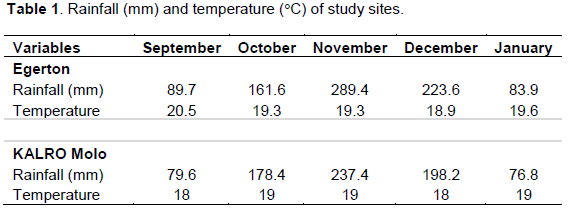
Land preparation was carried out manually which involved ploughing and harrowing to obtain fine tilth for planting of rooted apical cuttings. The rooted apical cuttings, obtained from Stokman Rozen Company located in Naivasha Kenya, were planted at spacing of 0.75 m between plants and 0.35 m between rows. Triple super phosphate (46% P2O5) fertilizer was applied as per the treatment rates in the planting holes and mixed thoroughly with the soil. Recommended doses of urea and potassium fertilizers were applied as follows; Urea (46%) at rate of 50 kg N ha-1, in two splits; two weeks after planting and during the potato vegetative stage prior to flowering and Muriate of potash (60% K2O) at rate of 30 kg K ha-1 as basal fertilizer during planting to supply K. Pests like cut worms were controlled by application of Alpha Cypermethrin (Tata Alpha 10 EC-15ml/20 litres water) immediately after planting. Diseases like late blight was controlled by spraying with protective fungicide Ridomil gold (Metalaxyl 40g/kg + Mancozeb 640g/kg) at dose of 40 gms/20 litres water fortnightly until plants attained 50% physiological maturity. Manual weeding was done at two weeks after planting and during crop growth. Earthing up was carried out during tuber initiation to protect tubers from direct sunlight.
Data collection
Growth measurements
Plant survival per plot was determined fourteen days after planting, by manual counting. Three tagged plants in the two middle rows were used for measuring growth parameters. The number of stems arising from the main plant was counted. Plant height was measured, using a ruler, from the base of plant to the apex of the shoot fortnightly; from 14 days after planting (DAP) up to 56 DAP, before flowering of potatoes. Days to attainment of 50% flowering by 50% of the plant population were recorded. Days to physiological maturity was determined when 50% of the plant leaves had turned yellow.
Yield determination
The plants were harvested after three months when they had reached maturity stage. Shoot biomass weight was determined from the fresh weight. Total number of tubers and tuber weight were measured from three hills per plot and the average determined. Tubers were graded into three sizes: large (>60 mm diameter), medium (30-60mm diameter) and small (<30 mm diameter). Marketable tuber yield was determined by counting number of large sized and medium sized tubers. Number of eyes was counted on the randomly selected tubers.
Phosphorus uptake
The third to sixth leaf from the growing tip was sampled two times: 42 days after planting (prior to flowering) and 84 DAP (prior to maturity). Tubers were also sampled after harvesting. Total P concentration (g kg-1) was determined using the Vanadomolybdate yellow method (Okalebo et al., 2002).
The PUE was calculated using the following formula (Fixen et al. 2015);
PUE (kg kg-1) =
Statistical analysis
All of the crop data collected were tested for normality and subjected to general linear model procedure analysis using SAS version 9.3 software to generate analysis of variance (ANOVA). Least significance difference was used to separate treatment means, where F test was significant. Correlation analysis was done to show the relationship between growth parameters and yield of potatoes.
The soil pH was slightly acidic with values varying from 5.78 to 6.06 (Table 2). The soil had adequate nitrogen, moderate organic carbon and potassium. The soils had available P contents of 25 to 30 ppm, which was adequate according to rating by Landon (1991) (Table 2).
Growth of potato
Plant survival
Plant survival was generally higher at 14 to 28 days after planting (DAP) as compared to 42 and 56 DAP (Figure 1). The rooted apical cuttings were acclimatized to the external environmental conditions through hardening them in the screen houses for 30 days before transplanting to the open fields. The ability of the plants to withstand the new environmental conditions increases their ability to survive until maturity. Tsoka et al. (2012) reported that potato plants derived from apical stem cuttings survive better than tissue culture plantlets.
The main effects of P rates on plant survival was significant (P<0.05) at 14 and 28 DAP. Potato plants in treatments 0, 30 and 60 kg P ha-1 recorded the highest survival during these periods. The initial soil analysis showed that the soils were rich in organic carbon, total N and available P with good bulk density and soil texture. These soil properties enhanced the growth of the plants even in the control treatments where P fertilizer was not applied. Phosphorus is a vital nutrient in early crop growth and metabolism processes. This is in conformity with the report of Grant et al. (2001), that adequate P application is important for the earliest stages of crop growth. The interaction effect of location and variety on plant survival was significant (P<0.05) at all sampling periods. At 14, 28 and 42 DAP, all varieties at Egerton site had highest survival (Table 3). The differences in survival in the study areas could be attributed to differences in climatic conditions (Öztürk et al., 2010).
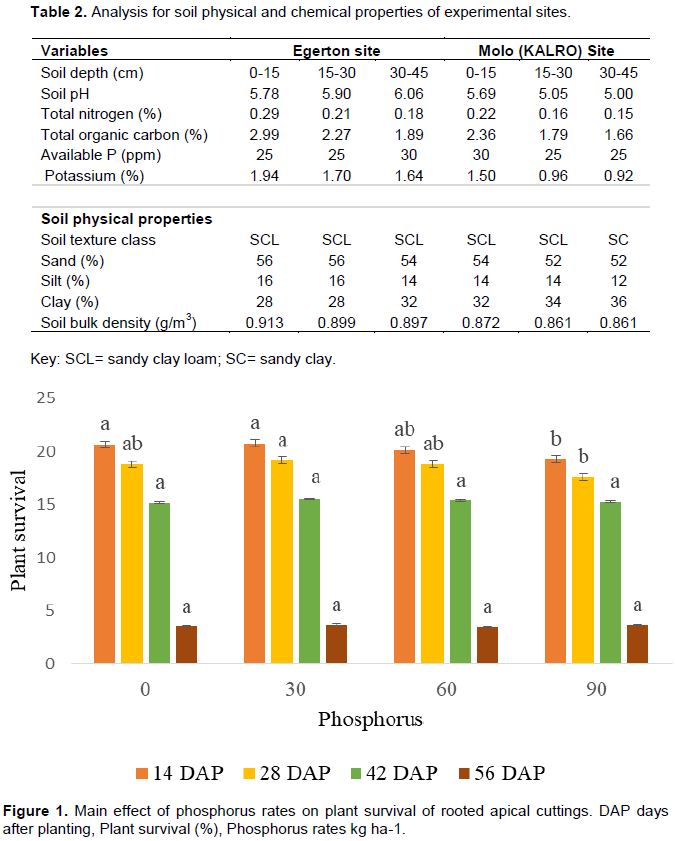

Number of stems
The number of stems per plant increased with plant growth. The main effect of phosphorus rates on number of stems was highly significant (P<0.001) at 28, 42 and 56 DAP. The plots in which P was applied at 30, 60, 90 kg P ha-1 recorded significantly higher number of stems per plant compared to the control treatment. The control treatment recorded the least number of stems per plant (Figure 2). The interaction effects of location and P rates on number of stems was significant (P<0.05) at 28 DAP. Phosphorus application rates of 30, 60 and 90 kg P ha-1 at Egerton site recorded higher number of stems of 4.25, 4.17 and 4.25 respectively, as compared to KARLO Molo with 3.75, 3.42 and 4.08, respectively. Application of P enhanced early crop development (Belachew, 2016; Ekelof, 2007). Studies on potatoes grown under field conditions have reported results similar to the present study with least number of stems per plant in control compared to fertilized treatments (Zelalem et al. 2009; Nizamuddin et al., 2003; Alam et al., 2007; Hassanpanah et al., 2009). Rosen and Bierman (2008), Kumar et al. (2012) and Misgina, (2016) reported increased number of potato stems per plant with increase in P rates.
The interaction effect of location and potato varieties on the number of stems per plant were significant (P<0.01) at 28, 42 and 56 DAP (Table 4). At 28 DAP, Shangi and Unica varieties at Egerton had significantly higher number of stems (4.5 and 4.0, respectively). At 42 DAP, Shangi, Dutch Robyjn, Unica and Wanjiku varieties at Egerton site had highest number of stems of 9.92, 9.17, 8.75 and 8.0, respectively. At 56 DAP, all the varieties had higher number of stems at Egerton site as compared to KALRO Molo. The environmental conditions and genetic makeup of varieties might have influenced the plant growth response (Asfaw et al., 2015; Abalo et al., 2003; Kaguongo et al, 2010).
Plant height
Plant height increased with time at both sites. The results showed that the interaction effect of study sites and P rates on plant height was significant (P?0.05) at 28, 42 and 56 DAP (Table 4). The P application rates of 30, 60 and 90 kg P ha-1 at 28 and 42 DAP in KARLO, Molo and 56 DAP in Egerton resulted in significantly higher (P<0.05) plant heights.
Phosphorus boosts the metabolic activity of the plants during the early growth stages that encourage stem elongation (Ekelof, 2007; Birtukan, 2016). This result agrees with the work of Firew et al. (2016), Belachew, (2016) and Misgina (2016), who reported increases in height of potatoes with increase in the amount of P applied.
The results showed that the interactive effect of location and variety on plant height was significant (P?0.05) at 14, 28, 42 and 56 DAP (Table 4). Shangi variety at KARLO Molo had significantly (P<0.05) higher height at 14 and 28 DAP. At 42 DAP, significantly higher (P<0.05) plant heights were observed in Shangi Unica and Wanjiku varieties at KARLO Molo. At 56 DAP Shangi variety recorded the highest plant height of 34.82cm at Egerton study site. The soil organic matter, which was moderate in both sites, releases plant nutrients slowly, hence providing nutrients over a longer period for crop growth; improves water holding capacity of the soils and acts as pH buffer (Kumar et al. 2012).
Days to 50% flowering
The main effect of P rates on days to 50% flowering of potato was significant (P<0.05). The plots with 90 kg P ha-1 flowered at 56 DAP as compared to plots with 0, 30, 60 kg P ha-1 that flowered at 57 DAP. This contradicts the findings of Zelalem et al. (2009) and Misgina et al. (2016). They reported that increased P rates delayed the days to 50% flowering of potato plants.
The interaction effect of location and variety significantly (P<0.001) influenced days to 50% flowering (Table 5). Shangi flowered faster at both KALRO Molo site and Egerton site; after 45 days and 49 days, respectively. Unica almost took the same days to flower at both the study sites with difference of one day only. Dutch Robyjn and Wanjiku flowered three days earlier at Egerton site as compared to KALRO Molo study site. The differences in the number of days to 50% flowering could be due to varietal differences in period to maturity due to genetic makeup and response to the environmental conditions (Kaguongo et al, 2010).
Days to 50% physiological maturity
The results showed that the main effect of P rates on days to 50% physiological maturity was not significant (P?0.05). The study soils had sufficient initial P levels, hence the non-significant differences. On the contrary, Zelalem et al. (2009) and Misgina (2016) reported delayed days to 50% physiological maturity of the potato plants with increased P rates. They attributed this to sustained physiological activities of the plants excessive accumulation of photosynthetic assimilates that lead to continued photosynthesis and growth of the plants.
The main effects of variety and location on days to 50% physiological maturity were highly significant (P?0.01). Shangi variety attained 50% physiological maturity earlier followed by Unica then Dutch Robyn and lastly Wanjiku variety. The differences in the days to physiological maturity could be due to varietal differences, whereby Shangi and Unica are early maturing while Dutch Robyjn and Wanjiku are medium maturing varieties.
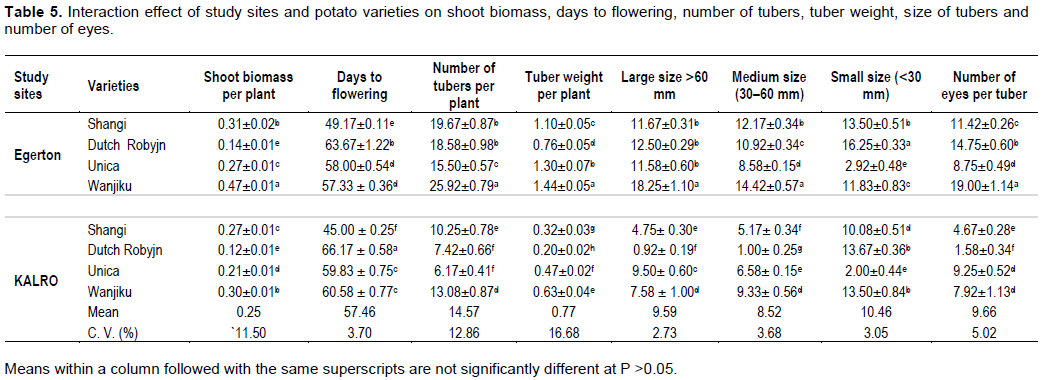
Phosphorus uptake and use efficiency of Potato
Phosphorus uptake prior to flowering
The interaction effect of location and variety on phosphorus uptake prior to flowering stage (leaves sampled at 42 DAP) was significant (P?0.01). Dutch Robyjn variety at Egerton study site and KARLO, Molo, and Unica variety at KALRO, Molo had high P uptake. Shangi and Wanjiku varieties showed lower P uptake at both study sites. The interaction of varieties and P rates on P uptake was significant (P?0.01). Phosphorus rate of 30 kg P ha-1 and Unica variety recorded the highest P uptake (0.36%) followed by Dutch Robyjn variety and rates of 60, 90, 30, 0 kg P ha-1 with 0.30, 0.30, 0.29 and 0.27% P uptake, respectively. The variety Wanjiku grown with 90 kg P ha-1 applied and Shangi variety grown without P (0 kg P ha-1) showed the least P uptake of 0.18 and 0.17 %, respectively.
The interaction of study sites and varieties on phosphorus use efficiency was significant. Potato varieties with high PUE recorded the highest marketable tuber yield. This could be attributed to the ability of the varieties to acquire P from the soil and utilize it for biomass accumulation and yield. Wanjiku and Unica variety had high P acquisition and utilization ability which led to increase in yield as in conformity with the findings of Nyiraneza et al. (2017). This results also agrees with findings (Bayuelo and Ochoa, 2014; Fernandes et al., 2014; Wishart et al., 2013) that reported that differences in phosphorus utilization efficiency is influenced by cultivar characteristics such as root weight, root length and diameter.
Phosphorus availability in the soil is affected by the soil pH and is more available at slightly acidic soils (Hopkins et al., 2014). The soil pH at the study sites was at a range of 5.0 to 6.21 which might have favoured availability of phosphorus to the potato crops. This availability made the acquisition of phosphorus by the plants easy and led to increased phosphorus use efficiency and increased yield. This result is in conformity with findings of Hopkins et al. (2014), Rosen et al., (2014) and Thornton et al. (2014), who reported that soil pH affects the availability of phosphorus in the soil.
Phosphorus uptake prior to maturity
The main effect of P rates on P uptake was significant (P?0.01). Phosphorus rates of 30 and 90 kg P ha-1 recorded higher P uptake values of 0.43% and 0.41%, respectively. The control treatment 0 kg P ha-1 recorded higher P uptake than 60 kg P ha-1 with values of 0.39% and 0.37%, respectively. The main effect of variety on P uptake was significant (P?0.001). Unica variety recorded the highest P uptake value of 0.47% followed by Dutch Robyjn Wanjiku and Shangi varieties with values of 0.39%, 0.38% and 0.37%, respectively.
The main effect of location on P uptake by the potato tubers was significant (P?0.05). The tubers at Egerton recorded higher P content of 0.18% as compared to KALRO Molo with a value of 0.11%. The study soils were slightly acidic (5.0 to 6.21) and had moderate carbon levels; these chemical properties favoured the availability and assimilation of applied P (Hopkins et al., 2014; Thornton et al., 2014; Rosen et al., 2014; Blake et al., 2000; Benbi and Brar, 1994).
Phosphorus use efficiency
The main effect of P rates on PUE was significant (P<0.001). The potato crops grown with application of 30 kg P ha-1 recorded the highest PUE of 239.79 kg kg-1 followed by 60 kg P ha-1 (126.40 kg kg-1) and 90 kg P ha-1 (73.45 kg kg-1). These results agree with findings of Nyiraneza et al. (2012), who reported that PUE was higher in fertilized plots. The effect of interaction of location and varieties on PUE was significant (0.01). Higher values were observed with Unica variety at Egerton study site (284.88 kg kg-1) and Wanjiku variety at KALRO, Molo (218.7 kg kg-1). The differences in PUE amongst the varieties could be attributed to differences in rooting traits. Bayuelo and Ochoa (2014), Fernandes et al. (2014) and Wishart et al. (2013) similarly reported that phosphorus utilization efficiency was influenced by cultivar characteristics such as root weight, root length and diameter (Kawakami and Iwama., 2012).
Yield of Potato
Plant shoot biomass
The interaction between study sites and varieties on plant shoot biomass was highly significant (P?0.001). Wanjiku variety at Egerton study site registered the highest shoot biomass followed by Shangi and Wanjiku at Egerton and KARLO Molo, respectively (Table 5). The interaction effect of P and varieties on plant shoot biomass was significant (P?0.01). Wanjiku and Dutch Robyjn varieties registered the highest and lowest plant shoot biomass across all P treatments respectively (Table 6). Higher shoot biomass for Shangi and Wanjiku varieties could be attributed to genetic makeup that supports vegetative canopy development and shoot biomass accumulation (Shunka et al., 2017). Zelalem et al. (2009) reported an increase in potato biomass weight after application of N, P and K fertilizers.
Number of tubers
The main effect of P rates on number of tubers was highly significant (P?0.01). Treatments did not significantly influence tuber numbers. The initial soil analysis showed that the study soils had adequate levels of total N and moderate levels of organic carbon. This in addition to applied P could have promoted the growth and photosynthesis rate of the plants and tuber formation. Chala et al. (2017) and Zelalem et al. (2009) reported increase in growth of potato plants due to application of P. Mona et al. (2012) also reported increase in the number of potato tubers per hill with increasing amounts of NPK fertilizers applied in the soil. The results of the study showed that the interactive effect of location and potato varieties on the number of tubers was highly significant (P?0.01). The highest number of tubers was registered with Wanjiku variety followed by Unica and Shangi at Egerton study site. Wanjiku variety had more stems and this could have contributed to the increased number of tubers. The correlation between the number of tubers and number of stems was positive (Table 7). The rate of vegetative growth of the variety contributes to high number of stems which correlates with the number of tubers formed (Belachew, 2016; Chala et al., 2017).
Tuber weight
The main effect of P rates on tuber weight was highly significant (P<0.001). The P rates of 30, 60 and 90 kg P ha-1 recorded tuber weights of 19.30 kg, 19.84kg and 18.88 kg ha-1, respectively. These were not significantly different, but higher than the control treatment (0 kg P ha-1) which recorded tuber weight of 15.55 kg ha-1. The results of the study showed that interaction of location and varieties on tuber weight was highly significant (P<0.01). Wanjiku variety recorded heaviest tubers at Egerton study site while Dutch Robyjn variety registered the lowest tuber weight at KALRO Molo (Table 5). The study soils had moderate amounts of organic matter content and adequate total N and this contributed to tuber weight. The factors that affect tuber weight are variety, location, organic matter content and total nitrogen (Zelalem et al., 2009). In a study on growth, nutrient uptake and dry matter partitioning in potato plants under different combinations of potassium, nitrogen and phosphorus, Jenkins and Mahmood (2003) reported that the response of potatoes to single deficiencies may be influenced greatly by levels of other nutrients. Misgina (2016) reported that increase in tuber weight can be associated with adequate photosynthetic products translocated to the reproductive structures.
Size of tubers
The result of the study showed that the interaction effect of location and varieties on size of tubers was significant (P?0.001). Wanjiku variety at Egerton study site recorded the highest number of large (?60mm diameter) and medium sized tubers (30-60mm diameter). Dutch Robyjn at Egerton site registered the highest number of small sized tubers (?30mm diameter) followed by Shangi at Egerton and Wanjiku at Molo. Unica variety had the least number of small sized tubers at both the study sites (Table 5). The differences in size of tubers could be attributed to environmental factors like soil moisture, rainfall and varietal differences. Egerton study site received higher amounts of rainfall and warmer temperatures which led to improved photosynthesis and dry matter accumulation in the tubers. According to the study by Otroshy (2006), changes in day and night temperatures were reported to reduce the number of mini tubers formed per cutting. The interaction effect of P rates with potato variety on size of tubers was highly significant (P?0.001). Wanjiku and Unica varieties with 30, 60 and 90 kg P ha-1 registered the highest (P<0.001) number of large sized tubers and medium size tubers (Table 6). Phosphorus application leads to increase in formation of medium size tubers (Gitari et al., 2018) and large size tubers (Belachew, 2016). Combination of 0 and 90 kg P ha-1 with Dutch Robyn produced small sized tubers. Similar results were obtained with Wanjiku variety grown with 60 kg P ha-1. The high numbers of small sized tubers resulted in lower yields. Phosphorus plays several plant functions including photosynthesis and transformation of sugars and starches. It also increases accumulation of assimilates that are converted into carbohydrates in tubers which increases tuber size (Chala et al., 2017; Merga, 2018).
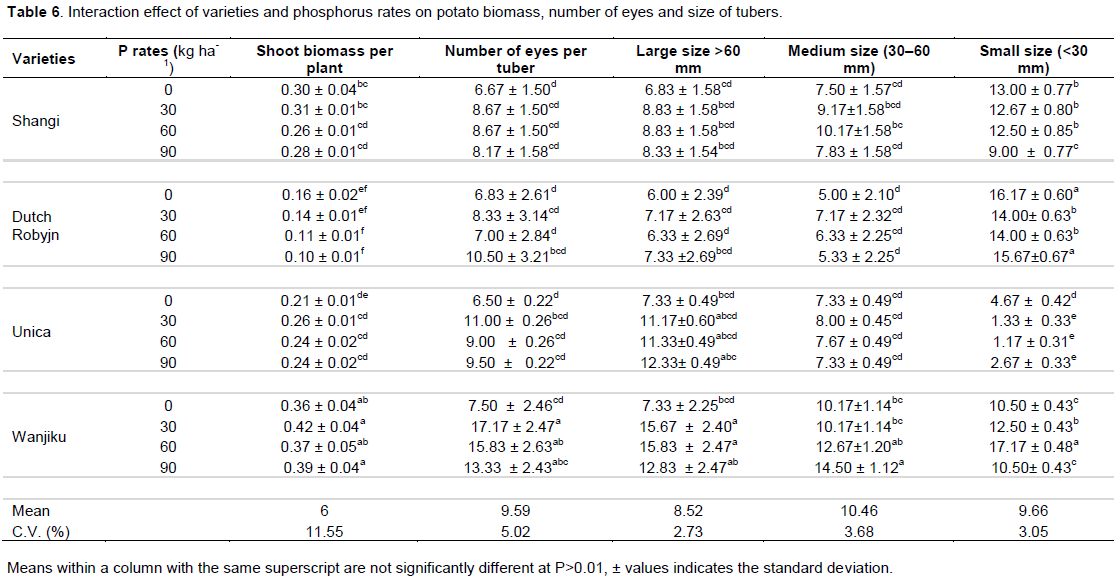
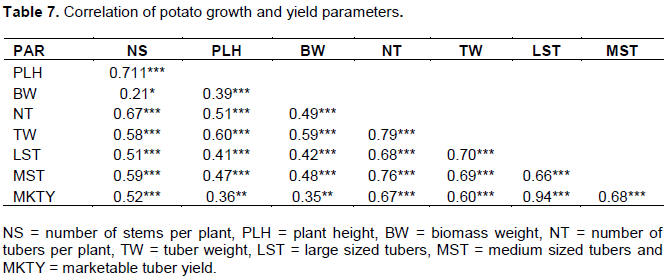
Number of eyes
The results of the study showed that interaction effect of location and varieties on the number of eyes was highly significant (P?0.001). Wanjiku variety grown at Egerton study site had the highest number of eyes followed by Dutch Robyjn then Shangi and Unica in that order. These varieties recorded least number of eyes at KALRO Molo site (Table 5). The interaction of P rates and varieties significantly (P?0.05) influenced the number of eyes. The interaction of 30, 60 and 90kg P ha-1 with Wanjiku recorded highest number of eyes (Table 6). The size and shape of tubers affected the formation and number of eyes. Wanjiku had higher number of large and medium size tubers which correlated with high number of eyes on tubers. The higher the number of eyes in tuber is the higher the quality of the seed. New potato plants sprout and grow from eyes. Lung’aho et al. (2006) reported that farmers selected seed potato based on the number of eyes as it is related to number of stems produced which correlates with yield. In this study the correlation between number of stems and yield was positive (Table 7).
Marketable tuber yield
The main effect of P application rates on marketable tuber yield was significant (P?0.05). Application rates of 30, 60 90 kg P ha-1 recorded the highest marketable tuber yields of 9.6, 9.5 and 10.25 tubers per hill, respectively. These values were however not significantly different but higher than the control (0 kg P ha-1), with 9.25 tubers per hill. Increasing P rate to 90 kg P ha-1 caused a 10 % increase in the marketable tuber yield. The marketable tuber yield was positively and highly correlated with large sized tubers, and medium sized tubers. The main effect of varieties on marketable tuber yield was significant (P?0.001). Shangi recorded the highest number of marketable tubers followed by Wanjiku and Dutch Robyjn with 10.66, 9.87 and 9.54, tubers per hill, respectively. The least was observed for Unica with 8.58, tubers per hill. Varieties have different P requirements and P uptake which influences P utilization by the plants (Tein et al. (2014). The main effect of study sites on marketable tuber yield was significant (P?0.01). KALRO Molo site registered the highest marketable tuber yield of 9.83 tubers as compared to Egerton study site with 9.5 tubers. This may be attributed to specific site conditions in Molo that favoured to higher marketable tuber yield. The subsoil in Molo site was sandy clay which improves water holding capacity and sustains soil moisture that supports tuber bulking. The prevailing factors of environment, rainfall and soil moisture determine the yield of the crop (Chala et al., 2017).